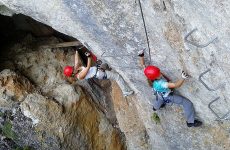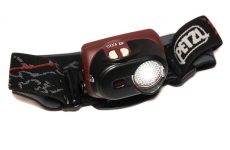
When you are looking to buy the best climbing rope, it’s important to understand both the differences between rock climbing ropes, and also how rope is used during different types of rock climbing activities.
Let's take a look at the different specs involved in some of the most popular climbing ropes:[table “11” not found /]
There are technical differences around elongation, weight, diameter, and length. There are also other differences between ropes used for rock climbing than just the technical specifications though, such as safety certifications, markings, treatments, and more.
Different ropes are better suited to different usage, so it helps to get a better understanding to choose the right climbing rope. For example, heavier climbers create more of an impact during falls and should consider heavier ropes that can take more impact.
Now, let's take a closer look at the areas of differences between these different ropes used for rock climbing:
Elongation: Static Ropes vs Dynamic Ropes
The difference between static and dynamic ropes is the amount of stretch that the rope will take when it is loaded and a fall takes place. Static and Dynamic Elongation are calculated and rated differently.
The higher the Dynamic Elongation, the less the impact of the fall is on the climber. The lower the Static Elongation is, the better the rope is for being set as a stable fixed line.
Static Ropes
- Designed to be strong and durable, resistant to abrasion, and often treated to withstand water.
- Have a small amount of stretch when they are weighted.
- Popular for hauling gear, and for setting fixed ropes used in ascending and descending.
- Generally static ropes are rated with higher strength ratings, and they are usually the strongest type of climbing rope because they are thicker and heavier.
- As strong as they are for weight, they not designed to take the force of large weighted falls.
Popular Static Climbing Rope Comparison
[table “12” not found /]The lower the Static Elongation, the better the rope is for being set as a stable fixed line.
Dynamic Ropes
- Have more stretch in the rope when weighted.
- The more dynamic the rope, the further your fall will be, as the stretching of the rope elongates the fall.
- There is less of an impact on the climber due to the stretch in the rope absorbing more of the fall.
- Popular for all types of lead climbing as when you are falling from above the anchor.
- You will take much bigger falls and need the shock absorbed more with the rope’s dynamic stretch.
Popular Dynamic Climbing Rope Comparison
[table “13” not found /]The higher the Dynamic Elongation, the less the impact of the fall is on the climber.
Certification: Single Ropes vs Half Ropes vs Twin Ropes
The type of load a climbing rope was safety tested for determines the way that the rope (or ropes) are meant to be used as a best practice. Certain ropes are designed to be used alone, but there are other types of ropes where you would never use as a single rope.
Single Ropes

Single Ropes are marked with a circled 1 on each end of the rope.
- The most common type of rock climbing rope that you’ll see in most indoor gyms, and at the most popular sport climbing spots outdoors.
- Designed to be used by itself in single rope climbing techniques.
- Can also be used in a half rope or twin rope setup, but they are the only type that can be used for single rope climbing.
- Suitable for most single rope sports climbing, top rope gym climbing, outdoors and trad climbing purposes.
To take a look at the best selling and most popular single rope style climbing ropes, take a look at our favorites: the Black Diamond 9.6mm, the Mammut Infinity and the Petzl Contact.
Half Ropes

Half ropes are marked with a circled 1/2 on each end.
- Designed to be used as a matching pair.
- Each time you clip in to a bolt, the rope to use is alternated depending on whether it is on the right or the left side.
- Half-rope setup results in less rope drag, especially when the routes go zigzagging right to left a lot.Considered more difficult to manage and heavier than a single rope setup.
- Some climbing gyms have restrictions on they type of safety gear you can use, so make sure they’re ok with a half-rope set up before you try to use them indoors.
Twin Ropes

Twin ropes are marked with a circled infinity symbol on each end.
- Designed to be used 2 at a time as a matching pair, providing the redundancy of using 2 ropes.
- Both ropes are clipped in to the same bolt each time you clip.
- Twin ropes tend to be lighter and thinner than half ropes.
Safety: Strength and Fall Rating

Look for climbing ropes certified by the UIAA, the International Mountaineering and Climbing Federation (CE EN 892).
- Always make sure you are buying gear that has been thoroughly tested and rated.
- Fall Ratings are calculated using a load and impact that far exceeds the amount of force you will be generating simply by using the rope for fall protection on climbing routes.
- If you are in doubt, search for your climbing rope’s safety certification
- A higher strength rating and a higher fall rating generally means the rope will last longer.
Specs: Length, Diameter, and Weight
The basic specifications of what your climbing rope is are also important, but you might not realize why these things make a difference. For example, if you’re looking for a climbing rope for the walls at your indoor gym, it might not need to be as long or as rugged as the type of rope you would want for outdoor search and rescue operations.
Length
- The right length for a climbing rope is determined by the height of the routes you want to be able to climb.
- The rope must be double the length of your climb so that when the rope is doubled up it can still reach the anchor to the ground.
- Most ropes come in different lengths so you can buy a smaller or longer one depending on need.
Diameter and Weight
- The smaller and lighter the rope, the easier it will be to handle and to carry the weight.
- Twin ropes come in a much smaller diameter than all the other types of ropes, since they are meant to be used with two.
- Static ropes are usually the biggest diameter for more stability and durability.
- Since ropes are available in different lengths, the weight is usually shown as grams per meter.
Everything Else: Additional Features and Treatments
A climbing rope provides the very basic features of load and shock absorption, and that’s its most important job. However there are other nice to have features that stand out among some of the most popular climbing ropes.
Dry Treatments
- Different dry treatments can make the rope not absorb water
- Popular with outdoor climbers and especially winter and ice climbing usages
- For most climbing ropes used indoors, or if you’re going to pack up as soon as it starts raining, no dry treatment is probably fine.
Middle Marks
- Some climbing ropes have a marking on the middle of the rope so that you can easily see by view when you’re halfway done the rope.
- Some climbing ropes can change colors or patterns on both half of the rope as a visual aid to identifying the middle
End Marks
- Some climbing ropes have marks showing that the end of the rope is coming up.
- Popular for rapelling or lowering climbers
We hope this has helped you understand how to choose the best climbing rope for your intended purpose. Now, check out our reviews of the most popular climbing ropes and hopefully you will be able to choose the right one for you!


